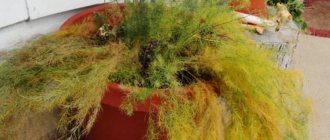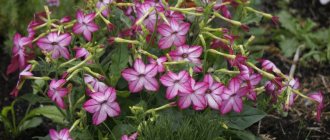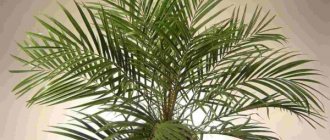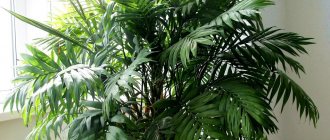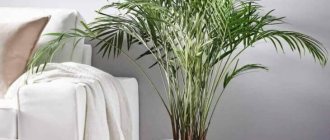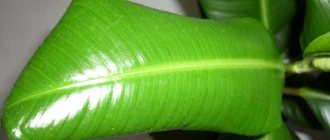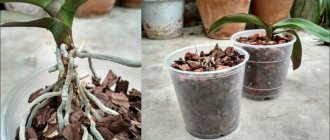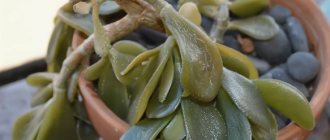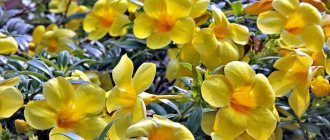Exotic cultures are often famous for their beautiful and unpretentious “character”. But, unfortunately, palm diseases at home cannot be called rare. Such a tragedy in the life of a plant is a consequence of improper maintenance of the flower. Therefore, the main task of the gardener should be to create a favorable microclimate, as close as possible to the tropical one. Initially, you should take care of air humidity, since the heat-loving tree does not tolerate dryness around the green mass. In 9 out of 10 cases, this is what leads to death.
Leaf dying is a natural process for most plants. In a palm tree, these scars form a majestic trunk. Nevertheless, its indoor varieties should be kept in a green state for as long as possible.
Carrying out preventive measures will help protect a small greenhouse from the harmful effects of pathogenic microorganisms. However, there are situations when plants still show signs of serious illnesses. Then you need to look for the reasons for their occurrence, and then organize a competent treatment session.
Major diseases and shortcomings of care
Why do the tips of the date palm leaves dry out? Why do spots appear? Date palm ailments can be associated with both disease and poor care .
Fungal and viral diseases
Various pathogens
are to blame for date palm diseases :
- Fungi.
- Viruses.
- Bacteria.
Among fungal diseases, gray spot . Signs of the disease are gray spots on the leaves, more so on older ones. As the disease progresses, black spots appear - these are fungal spores.
For treatment , it is necessary to remove all infected parts before the disease affects the entire plant. Next, the palm tree is treated with fungicides - special antifungal drugs. The same remedies are also applicable for another, no less common fungal disease - pink rot.
Bacteria lead to putrefactive processes. They are characterized by soft stems and leaves, which also become discolored and fall off. The appearance of bacteria is promoted by increased soil moisture and keeping them in a cold room.
If a mosaic-type pattern appears on the leaves, this signals a viral infection. Most often, the plant is infected by insects , which must be promptly destroyed indoors. They may be:
- flies;
- mosquitoes;
- moths.
And other insects that can enter the room. For protection, mosquito nets should be installed on windows.
Once every six months it is necessary to carry out preventive treatment of plants with special chemicals.
Reasons for the loss of decorative appearance
Soil oversaturated with moisture can cause brown spots . Watering with cold water also leads to the same result.
Softening of the trunk , coupled with a putrid odor, also signals excess moisture, which threatens the life of the plant.
To check, you need to remove it from the pot and inspect it. If dead roots are found, you need to separate them from living ones and thoroughly clean them. Replant into another pot and into drier soil.
Date palm leaves are drying up, what should I do? If watering is insufficient, the leaves begin to wither and turn yellow . This may also be due to poor quality water - too hard or low in essential microelements.
But the same symptoms can also indicate too dense soil and associated moisture stagnation. The best solution in such a situation would be to replant into looser soil.
Brown coloring of the tips of the leaves is the result of insufficient air humidity. The same symptom is characteristic of hypothermia.
Dracaena (dragon tree)
Oddly enough, in the lists of the most popular indoor palm trees, the leader is almost always Dracaena - an African plant that has nothing to do with Palmaceae at all, but belongs to the Asparagus family.
The most commonly used species in indoor floriculture is known as Dracaena marginata. It looks very impressive, is unpretentious, grows quickly and reproduces quite easily.
In addition to this species, in an apartment you can cultivate small forms of Dracaena reflexum, fragrant, edged, Godsef, Sander (“lucky bamboo”), etc. Among them there are both green-leaved and variegated forms, as well as those whose leaves are “edged” in a different color.
In order to get new plants, you will need to wait for the appearance of a young semi-lignified shoot on the stem of the dracaena. It needs to be cut off with a sharp, disinfected tool as close to the trunk as possible and generously sprinkle both cut points with crushed coal.
For the first time, the cuttings are placed in a glass of water, where the root formation stimulator is dissolved, and placed in a place without direct sunlight. As soon as the shoot takes root, it can be placed in the main container with moistened universal soil (there must be enough space for the root system!). Do not forget to regularly water and spray the planted cuttings.
An adult plant does not tolerate overwatering and does not like direct sunlight, although it is worth choosing a well-lit place for it, and watering and spraying it generously regularly.
- How to propagate dracaena at home - step-by-step master class with photos
Growing dracaena fringed from a shoot, following certain rules, is not at all difficult - let's see this together.
Many of the dracaenas are effective air purifiers in the apartment, and, if necessary, they can neutralize very toxic substances such as formaldehyde, benzene or trichlorethylene.
Diseases and pests
The red spider mite is one of the main enemies of not only the date palm, but also many other indoor plants.
The size of the insect is only half a millimeter. It is bred in rooms with extremely low humidity and high temperature. It starts first in the stem, gradually spreading to the leaves.
Symptoms include gray or yellow spots and cracks. If no measures are taken, the green pet will die, completely covered in cobwebs. Particular attention should be paid in the spring, this is the time of the most likely infection.
The mealybug parasitizes leaves and young shoots, from which it sucks the juice. As a result of infection, the plant slows down its development and almost stops growing. The main symptom is a solid, cobweb-like white coating.
Thrips parasitize leaves, especially in their lower parts, laying eggs inside them. Damaged leaves become gray-brown in color and turn white at the top. Thrips can kill a plant: first the leaves turn yellow and fall off, and then the entire palm tree dries out.
The scale insect also feeds on plant sap and spreads very quickly. Insects gradually cover the entire palm tree, its surface becomes like tiny scales. As a result of loss of juice, the foliage withers and turns yellow, and the shoots may dry out.
The common spider mite parasitizes more than 200 species of cultivated plants, including the date palm. The insect damages the epidermis of the leaf and feeds on the sap of the plant, as well as chlorophyll grains. The leaf blade gradually darkens and dries out. Without treatment and insufficient watering, the plant dies.
Preventing plants from mealybug
Mealybug prevention is extremely simple. New flowerpots must be quarantined separately from other indoor flowers for at least a couple of weeks. It is advisable to treat them with antifungal drugs and insecticides at the same time.
It is imperative to keep the flowerpots clean and tidy and remove dry leaves and shoots in a timely manner. And also wash and spray those flowers that need it. After all, flower shops sell special fertilizers in sprays with protective additives.
Photo: landas.ru
Diseases of indoor plants: names, photos and how to deal with them
Ways to combat parasites
To rid your green pet of parasite attacks, there are several methods. As a primary treatment, you can soap the sponge and remove insects. However, such a procedure is not able to completely defeat the infection, so radical measures are used. The following preparations are used for spraying :
- phosphamide;
- fitoverm;
- actellik;
- pyrethrum.
The proportion of the chemical solution is 2 g per 1 liter. water. It is advisable to spray once a week.
Traditional disinfection is also suitable: wipe the infected areas with a cotton swab soaked in alcohol and spray the rest of the plant.
The date palm has been known to man for more than 2000 years. As early as the sixth century BC, it was grown in Mesopatamia and in the territory of modern Iran. No less popular are indoor species, which can be grown from seeds without much difficulty.
Chemicals for mealybugs
The easiest way is to use special tools. Usually they have a complex effect, so they will also help against other uninvited guests. In addition, modern formulations contain various useful components for indoor plants, so stereotypes about terrible chemicals have long had nothing to do with reality.
Fitoverm
This is a very popular, effective and low-toxic drug that is ideal for indoor plants. Due to its biological origin, it poses virtually no threat to humans and pets. To use, you need to dilute the concentrate with water and spray the plant. Usually the procedure needs to be repeated up to 4 times, but be sure to follow the instructions.
Photo: nn-sp.ru
Aktara
This is a complex insecticide that is also used for spraying. It can also be bred for irrigation against root pests. For greater reliability, we recommend combining both methods and repeating the procedure 2-3 times.
Photo: domashniecvety.ru
Biotlin
This is a contact-intestinal insecticide that was originally developed for garden plants. But it also shows excellent effectiveness against mealybugs. The active substance in the composition is quite dangerous, so carefully follow the dosage and precautions.
Photo: vseprodachu.ru
Confidor
This drug is completely harmless to indoor plants, but the pests die within a few hours. It is found in the form of granules and liquid concentrate. You need to dilute it in settled water and spray the plant along with the soil. A weaker solution can also be used for watering.
Photo: sadim.guru
Aktellik
This is a strong concentrated drug that is most often found in ampoules. It has a number of contraindications, and you can only work with it outdoors, so you will have to take the flowerpots to an unglazed balcony or street. But Actellik is very effective in cases of severe and advanced lesions.
Photo: sazhaemvsadu.ru
Did you like the post? Subscribe to our channel in Yandex.Zen, it really helps us in our development!
For health and freshness
How to rejuvenate a date palm? Renewal of the date palm consists of constant renewal of leaves that appear from above and die from below. It is necessary to remove fading or dried lower branches .
The top branches cannot be cut ! This can lead to the death of the plant. Drying of the upper branch is an unnatural process and signals a disease.
To give the plant freshness, the leaves need to be sprayed daily . Once a week, you can abundantly water the above-ground part of the plant, while covering the ground with film. It’s a good idea to wipe the leaves with a damp sponge; this will give the plant freshness and serve as additional prevention against parasites.
Hyophorba (bottle palm)
This unusual plant comes from the islands of the Indian Ocean, and even there, most of its species in nature are given endangered status. The thickened trunk of this tree really resembles a bottle in shape, in which a heap of long pinnately dissected leaves seems to be placed.
In indoor conditions, these palm trees grow slowly and, oddly enough, do not require very complex care. The main thing is to provide the plant with loose, fertile soil of neutral acidity, the best lighting (even direct sunlight is possible), provide abundant watering without stagnant moisture, and spray the crown from time to time. For the winter, it is worth establishing a dormant period - lower the temperature to 15-20°C and reduce the amount of watering. The plant reproduces only by seeds, which must first be scarified (break the integrity of the seed shell for better germination).
Chamerops (fan palm)
In nature, this tree is famous for being one of only two species of wild palms in Europe.
Chamerops squat with a thick “hairy” red-brown trunk and hard fan-shaped leaves lives mainly in the Mediterranean and reaches 4-6 m in height when growing wild; and if conditions permit, then even in an apartment such a palm tree can grow above 2 m (and Hamerops is very unpretentious).
In summer, the plant needs a lot of diffused sunlight (after adaptation, the palm tree can easily tolerate direct sunlight), fresh air, abundant watering and about 25 ° C heat. In the hottest weather, Hamerops will be grateful for spraying the crown. In winter, it will be quite happy with temperatures in the range of 7-15°C and even slight shading, and watering should be kept to a minimum. Hamerops is propagated by seeds or root shoots; an adult plant is replanted every 3-5 years, getting rid of excess lateral shoots.
Of course, we have not listed all the houseplants that are colloquially referred to as “palm trees,” regardless of whether they actually belong to the Palmaceae botanical family. Enthusiasts successfully grow caryota, cycas, butia, gouvea, chrysalidoarpus, areca, latania, rapis, brachea, cordyline, chamedorea, lycuala, trachycarpus, bocarnea, pandanus...
If you are also a fan of these large, spectacular tropical plants, be sure to tell us in the comments which palm tree you chose for your apartment and why.
